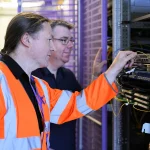Study Warns Internet Fibre Optic Links at Risk from Huge Solar Storm

Once every 100 years or so our sun emits a massive Coronal Mass Ejection (CMEs) and these can be enough to cause damage to certain electrical systems, satellites and power grids etc. But a new study has also warned of an “internet apocalypse” because the next such event could knock out critical submarine fibre optic cables.
The last major solar storm like this happened in 1859 (Carrington event) – causing significant damage to the old telegraph network of the day, which was followed by a similar event in 1921. In short, we’re perhaps due another one and that’s a problem because a lot of our modern technological society has evolved without having to experience such things (i.e. some electrical systems may not be as well-prepared as we’d like).
Just to clarify. CMEs are large expulsions of plasma and magnetic field from the Sun’s corona. When this hits the Earth it can interact with our planet’s magnetic field and produce Geomagnetically Induced Currents (GIC) on the crust, which can in turn enter and damage long conductors, such as power lines.
Advertisement
At this point some people may be scratching their heads and wondering how this could possibly impact optical fibre cables, which don’t use electrical signals or wires to transmit data and instead work by sending laser light over glass (silica) or plastic fibres. According to the ‘Solar Superstorms: Planning for an Internet Apocalypse‘ study, the issue isn’t the fibre, but rather the repeaters that are needed to boost such signals (these are often spaced at intervals of 50 – 150km and are powered using a conductor, which were found to be vulnerable to GIC-induced failures).
According to Sangeetha Abdu Jyothi, who helped to write the study and is Assistant Professor of Computer Science at UC Irvine, “We have NO IDEA how resilient the current Internet infrastructure is against the threat of CMEs!” Now consider that astrophysicists estimate the likelihood of a solar storm of sufficient strength to cause catastrophic disruption occurring within the next decade to be 1.6 – 12%, which is uncomfortably high.
Summary of Key Findings
➤ The distribution of Internet infrastructure is skewed when compared to the distribution of Internet users. The infrastructure concentration in higher latitudes poses a greater risk during solar storms.
➤ The investigation on the impact of GIC shows that submarine cables have a higher risk of failure compared to land cables. This is primarily due to their large lengths.
➤ The US is one of the most vulnerable locations with a high risk of disconnection from Europe during extreme solar events. Intra-continental connections in Europe are at a lower risk due to the presence of a large number of shorter land and submarine cables interconnecting the continent.
➤ In Asia, Singapore will retain good connectivity to neighbouring countries even under severe storms. Chinese cities are more prone to lose connectivity than Indian cities because they connect to much longer cables. The cables running along the eastern and western coasts of Africa are less prone to failures.
➤ The cable between Brazil and Europe has less probability of being affected compared to cables connecting the US and Europe.
➤ Australia, New Zealand, and other island countries in the region will lose most of their long-distance connections. But local connectivity, as well as connections to Singapore, are less vulnerable.
➤ A large fraction of ASes have a presence in vulnerable regions, however, the vast majority have a small spread. The extent of impact on an AS and its customers will depend on a combination of these factors.
➤ Google data centers have a better spread, particularly in Asia and South America. Facebook is more vulnerable.
➤ DNS root servers are highly distributed and hence not vulnerable.
A few key takeaways from the above. The impact of such a major CME would not be uniform across the globe, but “higher latitudes are at a higher risk” and that’s a problem because most subsea fibre optic cables are concentrated between America, the UK and Europe. Data centres are also concentrated in more vulnerable regions.
One positive is a that CME which originates in the sun reaches the earth at least 13 hours, but typically 1-3 days, later. This provides the infrastructure operators with a limited opportunity to devise a shutdown strategy that minimizes connectivity loss during and after impact. In power grids, since GIC is superimposed with generated current, a key strategy involves reducing or completely shutting down power generation.
Advertisement
A similar method could work, despite being hugely disruptive, to protect internet connectivity across the globe. However, this only provides limited protection since GIC can flow through a powered-off cable and there’s huge uncertainty about the challenges of switching back on so much infrastructure post-event.
But of course the human race has shown, most recently with COVID-19, that even when we know a major threat is likely to occur, then we often still end up being woefully underprepared for when it actually hits. Getting our political leaders to take such inevitable events seriously and take real action has often proven to be a major stumbling block, with many preferring to wait until one punches them square in the face.
Meanwhile, countries that put more effort into preparation for such things will suffer significantly less economic harm post-event, which could also be seen as a competitive advantage post-event. One way or another, these events will happen, and probably sooner than some people expect.
Mark is a professional technology writer, IT consultant and computer engineer from Dorset (England), he also founded ISPreview in 1999 and enjoys analysing the latest telecoms and broadband developments. Find me on X (Twitter), Mastodon, Facebook, BlueSky, Threads.net and Linkedin.
« Deutsche Telekom Boss Renews Speculation of UK BT Takeover






















































It seems to me this is another exaggerated fear like the so-called Y2K bug and Gregg’s running out of sausage rolls.
Only yesterday morning, after a particularly heavy evening involving six pints of Guinness and a large vindaloo, I experienced a Colonal Mass Ejection and yet the world kept turning and the internet stayed on.
It’s all a load of scaremongering I tell ya…
I am not an expert but if the sun has a bowel movement, it might cause a little more damage than just some shit stains on your tighty whities…
Wait…what? Greggs have run out of sausage rolls….PANIC!!!
The Y2K meltdown wasn’t exaggerated at all. It just didn’t happen because countless programmers spent countless hours making sure it didn’t happen.
CMEs on the other hand, are a simple fact of our Sun’s existence and no amount of people of any profession can prevent one. The only thing that can be done is to shield critical equipment against them, but nobody is willing to pay to insure against something that may happen up to 100 years from now. At least Y2K had a fixed date.
I would have thought that hundreds of metres of seawater would have given at least *some* shielding from charged particles. Perhaps they are concerned about currents injected from the cable endpoints? Seems like that would be easily managed.
I’d be more worried about the routers and switches in data centres, given their highly complex and dense silicon. Even moreso FTTC cabinets with all those copper antennas hanging off them. And satellites. And overhead power distribution cables. In fact, almost everything except undersea fibre cables.
Y2K was a “non event” exactly because so much effort went into mitigating it.
This is a very real risk but I, for one, would shed no tears of grief for the loss of Facebook 😉
I’m not sure why people think Y2K was a non-event. For a start, many systems would have stopped working completely without the effort to update them. The fact that there wasn’t a huge failure doesn’t mean the work wasn’t needed.
But beyond that, there were some issues. In the UK, Y2K caused a number of pregnancies to be terminated that actually were perfectly normal. That’s quite a serious medical event – and all because of a computer not being updated to deal with Y2K.
It was a non-event because most of the issues that it could have caused were mitigated against.
Planes didn’t lose avionics, industry continued working, energy carried on being delivered, etc.
There may have been some edge cases and isolated problems, but by and large life carried on as normal.
The “terminations of pregnancies because of Y2K bug” event sounds incredibly far fetched, I would be really curious to know more about that.
This is why you don’t want to off-shore your data. Where are your emails, documents stored? If north America…
Carrington events take place during high sunspot activity, currently each successive cycle is seeing lower to non existent sunspot activity, matching the Maunder minimum if it carries on for a few more cycles. To be filed away under need to watch when sun activity returns to normal, until then watch out for temps levelling off before then dropping.
unusually high number of sunspots recently https://youtu.be/EndF67TGlnY
Hell! first we got McDonalds running out of Milkshakes and now this!
When is this massive solar storm forecast to happen ? I must have missed this onfo in the article.
When somebody figures out a way to accurately predict exact dates for such a violent and dynamic celestial object, then maybe. In the meantime, as the article says, you can only make an educated prediction based on previous events and knowledge (i.e. roughly one every 100 years, with a 1.6 – 12% chance within the next decade).
One of these day’s we get hit with a major storm and knock out our electrical grid and all communication.. hopefully it’ll take out automobiles most that is pre 75 should still run. And we will go back 150 or so years.maybe that’s what we need.
I’d be more worried about nuclear reactor control systems being critically damaged, cables are far easier to fix than the mess created by an out of control reactor. These things don’t come with simple on/off switch.
It would surprise me greatly if critical infrastructure like that wasn’t shielded or didn’t have mitigation protocols in place for such an event.